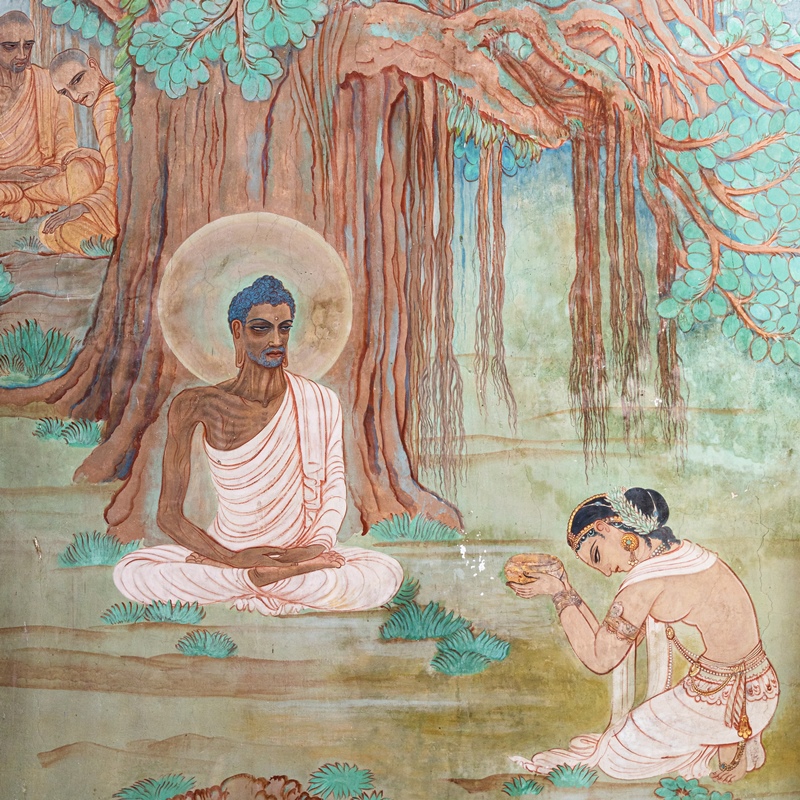Sarnath: Where Buddha's Words Took Flight
Introduction to Sarnath: Where Buddha's Words Took Flight
Overview of Sarnath's significance
- Located in the northern Indian state of Uttar Pradesh
- A renowned Buddhist pilgrimage site
- Holds immense historical and religious significance
- Attracts visitors and devotees from around the world
History and Importance of Sarnath in Buddhism
- Sarnath is where Lord Buddha delivered his first sermon after attaining enlightenment in Bodh Gaya
- The sermon, known as the 'Dhammacakkappavattana Sutta', set in motion the Wheel of Dharma
- Considered the birthplace of Buddhism as a religion
- Home to iconic structures like the Dhamek Stupa and the Ashoka Pillar
- Symbolizes the core teachings of Buddhism, such as the Four Noble Truths and the Eightfold Path
The Dhamek Stupa: Symbol of Buddha's First Sermon
The Dhamek Stupa history and architecture
The Dhamek Stupa in Sarnath stands tall as a symbol of Lord Buddha's enlightenment and the delivery of his first sermon. This ancient monument, originally constructed in the early centuries CE, showcases a blend of Indian and Greco-Buddhist architectural styles. The stupa's impressive height, intricate carvings, and solid cylindrical body adorned with intricate designs reflect the craftsmanship of that era. Visitors to Sarnath marvel at the grandeur of this structure that has withstood the tests of time.
Significance of the Dhamek Stupa in Buddhism
The Dhamek Stupa holds immense significance in Buddhism as it marks the very spot where Lord Buddha expounded the teachings of the Dhamma for the first time after his enlightenment. This sacred site symbolizes the dissemination of the Wheel of Dharma, the guiding principles of Buddhism that emphasize the path to liberation from suffering. Pilgrims and followers visiting the Dhamek Stupa are drawn to its aura of tranquillity and spiritual energy, making it a focal point for meditation and reflection. The stupa stands as a reminder of the profound wisdom and compassion that Buddha imparted to humanity, echoing his message of peace and enlightenment for all sentient beings.
The Chaukhandi Stupa: Commemorating Buddha's Visit
Chaukhandi Stupa overview
The Chaukhandi Stupa, situated in Sarnath, Uttar Pradesh, serves as a significant Buddhist monument commemorating an important event in the life of Lord Buddha. This ancient structure, believed to have been built during the Gupta period, stands out for its unique octagonal shape and intricate stone carvings. The stupa's design reflects a blend of Indian and Islamic architectural influences, showcasing the cultural exchange that characterized the region during that time. Visitors to Sarnath are captivated by the serene ambience of the Chaukhandi Stupa, which stands as a timeless testament to the rich spiritual heritage of Buddhism.
Connection of Chaukhandi Stupa to Buddha's Visit to Sarnath
The Chaukhandi Stupa holds a special connection to Lord Buddha's visit to Sarnath after attaining enlightenment. It is believed that upon his arrival in Sarnath, Buddha was welcomed by five ascetics who became his first disciples. The Chaukhandi Stupa marks the very spot where this significant meeting took place, symbolizing the beginning of Buddhism's spread in the region. Pilgrims and devotees visiting the stupa are reminded of Buddha's teachings on the Four Noble Truths and the Eightfold Path, which form the core principles of Buddhist philosophy. The Chaukhandi Stupa stands as a beacon of spiritual enlightenment, inviting visitors to reflect on the profound wisdom and compassion espoused by Lord Buddha.

The Mulagandha Kuti Vihara: A Sacred Monastery
Mulagandha Kuti Vihara's history and significance
Steeped in history and spirituality, the Mulagandha Kuti Vihara in Sarnath, Uttar Pradesh, holds immense significance for Buddhists worldwide. This revered monastery, which is believed to have been constructed where Lord Buddha spent the first rainy season after attaining enlightenment, stands as a testament to the deep-rooted connection between Buddhism and Sarnath. The Mulagandha Kuti Vihara's name translates to "the scent of root temple," signifying the fragrant roots that were part of Buddha's daily meal offerings. The monastery's architecture, adorned with intricate frescoes depicting scenes from Buddha's life, exudes a sense of tranquillity and devotion that resonates with visitors seeking spiritual enlightenment.
Importance of Mulagandha Kuti Vihara in Buddhist pilgrimage
For Buddhist pilgrims embarking on a spiritual journey, the Mulagandha Kuti Vihara holds a special place as a destination for contemplation and reverence. Pilgrims from various parts of the world visit this sacred site to pay homage to Lord Buddha and seek solace in the peaceful surroundings of the monastery. The Mulagandha Kuti Vihara serves as a hub for meditation practices, chanting, and prayers, allowing pilgrims to immerse themselves in the teachings of Buddhism and find inner peace. The monastery's serene ambience, coupled with the aura of holiness surrounding it, creates a conducive environment for spiritual growth and self-reflection. As visitors walk through the halls of the Mulagandha Kuti Vihara, they are enveloped in a sense of divinity and timeless wisdom, inspiring them to delve deeper into the profound teachings of Lord Buddha.

The Sarnath Museum: Preserving Buddhist Artifacts
Sarnath Museum's collection and significance
When you think of a place dedicated to preserving the rich history and cultural heritage of Buddhism, the Sarnath Museum immediately comes to mind. This museum stands as a guardian of countless artefacts that date back to the ancient roots of Buddhist art and civilization. Each item housed in the museum holds a profound significance, representing a tangible link to the teachings and life of Lord Buddha. The Sarnath Museum's collection serves as a visual narrative, offering visitors a glimpse into the artistic and spiritual achievements of early Buddhist societies. As you walk through the museum halls, you can't help but feel a sense of awe and reverence for the treasures meticulously preserved within its walls.
Noteworthy artefacts housed in the Sarnath Museum
Stepping into the Sarnath Museum transports you to a bygone era, where the craftsmanship of skilled artisans and the devotion of believers are encapsulated in each artefact. From intricately carved sculptures of Lord Buddha to ancient coins and inscriptions, the museum boasts a diverse array of relics that shed light on the evolution of Buddhist art and culture. Let's compare a few of the noteworthy artefacts housed in the museum:
| Artifact | Description |
|---|---|
| Buddha Statue | A sublime representation of Lord Buddha in a meditative posture, emanating peace and serenity. |
| Ashoka Pillar Capital | Symbolizing Emperor Ashoka's embrace of Buddhism and his principles of non-violence and compassion. |
| Gandhara Sculptures | Reflecting the influence of Greek and Roman artistic styles on Buddhist art in the ancient Gandhara region. |
As you explore the Sarnath Museum's exhibits, each artefact invites you to delve deeper into the cultural tapestry woven by the followers of Buddhism across centuries.
The Ashoka Pillar: Symbol of Emperor Ashoka's Legacy
History and significance of the Ashoka Pillar at Sarnath
The Ashoka Pillar at the Sarnath Museum stands as a testament to the enduring legacy of Emperor Ashoka, the great patron of Buddhism. This iconic pillar bears inscriptions and intricate carvings that speak of Ashoka's profound influence on the spread of Buddhist principles and his dedication to non-violence and compassion. The Ashoka Pillar is not just a physical structure but a symbol of the emperor's vision for a harmonious and peaceful society. It serves as a reminder of Ashoka's pivotal role in shaping the history and ethos of Buddhism in India and beyond.
Emperor Ashoka's association with Sarnath
Emperor Ashoka's association with Sarnath is deeply rooted in the history of Buddhism. It was at Sarnath, known as the place of the Buddha's first sermon, that Ashoka erected the famous Ashoka Pillar as a mark of his veneration for the teachings of Lord Buddha. The pillar at Sarnath is a historical landmark that signifies Ashoka's conversion to Buddhism and his subsequent efforts to promote the faith among his subjects. By choosing Sarnath as a site for such a significant monument, Ashoka solidified the town's importance in the annals of Buddhist history and ensured its enduring relevance in the cultural landscape of India.

The Thai Temple: A Cultural Connection
Thai Temple architecture and design
When you enter the Thai Temple, you are greeted by a mesmerizing blend of intricate carvings, vibrant colours, and awe-inspiring architecture. The temple's design reflects a harmonious fusion of traditional Thai aesthetics with modern influences, creating a space that exudes serenity and grandeur. From the ornate facades to the delicate statues that adorn the temple grounds, every element is a testament to the rich cultural heritage of Thailand.
Cultural ties between Thailand and Sarnath
As you explore the Thai Temple in Sarnath, you can't help but feel the deep cultural connection that exists between Thailand and this sacred site. Just as Emperor Ashoka's Ashoka Pillar symbolizes his devotion to Buddhism, the Thai Temple stands as a tribute to the close ties between Thailand and Sarnath. Through art, architecture, and shared spiritual beliefs, the cultural exchange between these two regions has flourished, reinforcing a sense of unity and shared heritage that transcends geographical boundaries.

Pilgrimage to Sarnath: Experiencing Buddhist Heritage
Guidelines for visitors to Sarnath
When you embark on a journey to Sarnath, immerse yourself in the tranquil ambience of the Thai Temple. Respect the sacredness of the surroundings by maintaining a reverent demeanour and embracing the spiritual energy that permeates the air. Remember to dress modestly and remove your shoes before entering the temple, showing reverence for the cultural traditions preserved within its walls. As you explore the grounds, take the time to reflect on the profound teachings of Buddhism and let the serenity of the environment uplift your spirits.
Essential experiences and activities for pilgrims at Sarnath
Begin your pilgrimage by witnessing the mesmerizing architecture and design of the Thai Temple, allowing yourself to be captivated by its intricate details and vibrant colours. Engage in meditation sessions within the temple premises, letting the echoes of ancient chants guide you towards inner peace and enlightenment. Explore the cultural ties between Thailand and Sarnath through guided tours and interactive sessions that highlight the shared heritage of these two regions. As you soak in the spiritual atmosphere of Sarnath, let the teachings of Buddhism inspire you to cultivate compassion, mindfulness, and profound spiritual insights.
